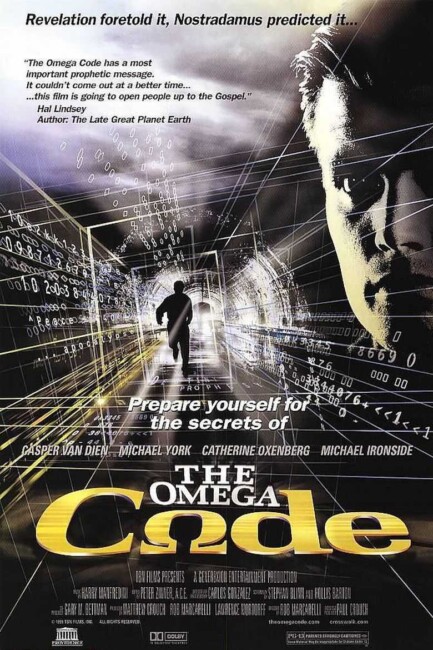USA. 1999.
Crew
Director – Robert Marcarelli, Screenplay – Hollis Barton & Stephan Blinn, Producers – Robert Marcarelli, Matthew Crouch & Lawrence Mortoff, Photography – Carlos Gonzalez, Music – Harry Manfredini, Digital Effects – Visionart (Supervisor – Ashley Christian), Special Effects Supervisor – Ron Trost, Production Design – Mark Harper. Production Company – Code Productions/Gener8Xion Entertainment/TBN Films.
Cast
Casper Van Dien (Dr Gillen Lane), Michael York (Chairman Stone Alexander), Michael Ironside (Dominic), Catherine Oxenberg (Cassandra Barashe), Devon Odessa (Jennifer Lane), Jan Triska & Gregory Wagrowski (Prophets), George Coe (Senator Jack Thompson)
Plot
Gillen Lane is a highly successful motivational speaker worldwide with his book ‘The Omega Code’, which interprets prophecies contained in a secret numerical code hidden within the pages of The Bible. Lane is approached by billionaire Stone Alexander who asks Lane to join his plan to bring about world peace. Initially cautious, Lane agrees to join Stone. Stone has great success, first uniting world leaders, bringing about world peace and then creating a one-world government with himself as leader. Gradually, Lane comes to see the sinister underside of Stone’s plan and realises that Stone is attempting to make the prophecies in the Book of Revelations and The Omega Code come true and become the Anti-Christ. Lane then sets out to stop Stone from getting the one missing piece of code he needs to declare himself the absolute ruler of the world.
It was The Omen (1976) that began a cinematic fad for what has become known in the trade as End Times Prophecies. End Times Prophecies are about the interpretation of The Book of Revelations in the Bible, which tells about the end of the world, the coming of the Anti-Christ, the Whore of Babylon, Satan’s rule on Earth and of course the Number of the Beast 666 being tattooed on everybody’s forehead. There is a great deal of theological debate about the symbolic meaning of all this, with the Whore of Babylon having been seen as everything from the EEC to the Catholic Church, the Anti-Christ interpreted in days of anti-Communist fervour as referring to the Soviet Union, and the Number of the Beast as referring to everything from bar codes to the Global Positioning System. Most End Times films however only copy the formula of The Omen, slavishly offering up novelty deaths to those who oppose Satan’s will and none of them return to the hallucinatory grandeur and paranoiac millenarism that inhabits the non-fiction work of real evangelical Christian theology. Even modern works like End of Days (1999) and Bless the Child (2000) draw on End Times cliches established by The Omen rather than return to the Biblical source material. (For a more detailed overview of the genre see Films About Biblical End Times Prophecies).
The Omega Code by contrast approaches the End Times film from a completely different perspective – it is earnest evangelical Christian doggerel masquerading as an End Times film. Where The Omen and imitators are horror films, The Omega Code‘s approach is more one of speculative drama. It was clearly made to exploit the arrival of the millennium, an event that was the locus of a great deal of heated fervour amid real End Times prophets.
The film comes funded by faith-based production companies. It even has Hal Lindsey, the granddaddy of End Times prophets and author of the seminal End Times work The Late Great Planet Earth (1970), as credited ‘prophecy advisor’. Although this is clearly no church yardsale-funded production – the film has a reasonable budget, employs moderately well known actors such as Casper Van Dien, Michael York, Michael Ironside (in about his 245th cold scowling villain role) and even Yugoslavian princess-heir Catherine Oxenberg in a supporting part. It was even given a respectable wide cinematic release worldwide where it did modestly successful business.

Evangelical Christianity seems to have been catching onto mainstream film-making as a place to get its message across in recent years with the likes of Raging Angels (1994), Time Changer (2002), Book of Days (2003), Gone (2003), Six: The Mark Unleashed (2004), The Visitation (2006), Fireproof (2008), Suing the Devil (2011), the chastity teen romance A Walk to Remember (2001), Revelation Road: The Beginning of the End (2013) and sequels, God’s Not Dead (2014), Heaven is For Real (2014) and Miracles from Heaven (2016). And that was before the big box-office surge of Christian films begun with Mel Gibson’s The Passion of the Christ (2004), The Chronicles of Narnia: The Lion, the Witch and the Wardrobe (2005), The Exorcism of Emily Rose (2005) etc. (For more detail see Christian Cinema).
Amid this, the End Times Prophecy mini-genre has been plumbed with almost obsessive regularity by the Toronto-based Lalonde Brothers and their Cloud Ten Pictures in their tetraology Armageddon (1998), Revelation (1999), Tribulation (2000) and Judgment (2001), and a further series Left Behind (2000), Left Behind II: Tribulation Force (2002) and Left Behind: World at War (2005), followed by the big screen remake Left Behind (2014). Around this same time, there was also the evangelical-produced The Moment After (1999), which similarly delved into End Times prophecies.
A number of reviewers quickly jumped on The Omega Code and trashed it, consigning it to the same Z-movie oblivion as L. Ron Hubbard’s Battlefield Earth: A Saga of the Year 3000 (2000), which seems to be the pit of death that any film arguing an ardent religious believer’s viewpoint gets these days. The Omega Code is not entirely bad – certainly not with the laughableness of Battlefield Earth – it is just an oddity. In clearly eschewing the patented horror approach of The Omen and imitators, it strains at trying to find a dramatic way to tell its story and only ends up resorting to generic cliches. Instead of an epic vision of Armageddon, it models its story along the lines of The Firm (1993) and The Devil’s Advocate (1997) with a junior corporate associate gradually discovering that his boss is The Anti-Christ (although Michael York’s role has been so heavily foreshadowed that such a revelation is no surprise at all).
The unveiling prophecies, Michael York’s One World Government, the proclamation of himself as the leader, his resurrection from the dead are all faithfully there. Contrarily, it tends to be stock thriller elements – car chases, the wronged man on the run – that dramatically drive the film rather than the prophecies. The film even adds a bogus sequence with Casper Van Dien being pursued by trucks in a tunnel, finding his family under surveillance and being betrayed by old friend George Coe, that adds nothing, merely generates faked frisson before a huge cop-out that reveals it all to be all a dream. Maybe it was just that the filmmakers felt the need to add something more visceral than the prosaic unfolding of prophetic events.

What is even more noticeable is how the dictates of B movie cliches of heroism and villainy end up creating a story that, despite the more-than-apparent religious earnestness of its creators, ends up rewriting The Book of Revelations for a more upbeat ending!!! According to The Bible, the coming of the Anti-Christ is supposed to herald Satan’s rule over the Earth for a thousand years. Contrarily, the film has the impossibly polished and handsome hero Casper Van Dien banishing the Anti-Christ and the film ending on the Earth’s transformation and renewal, a somewhat more upbeat ending than The Bible would have it.
There are other times when the plot tries to be a little too clever for its own good – rather than a standard Anti-Christ figure, the script tries to subvert cliche by making Michael York into a billionaire philanthropist who has the improbably self-fulfilling idea of setting out to make the prophecies come true and become the Anti-Christ himself.
For the most part, The Omega Code keeps the religious preaching relatively restrained. It only emerges into the open in scenes like where Casper Van Dien finds himself under demonic attack near the end and banishes the forces by proclaiming “Jesus save me.” Earlier the film has George Coe stand up in favour of marital fidelity: “We promised each other we’d stick it out, make it work no matter what. No matter what.” (Although one is not sure what to make of the symbolism afforded by such a message when later during the dream sequence Coe is revealed to be a traitor). The film seems to be assiduously avoiding too much connection with Christianity perhaps in an attempt to mass-sell itself – Casper Van Dien is a charismatic evangelist but the film tries to muddy this and instead make him a motivational speaker using interpretations of the Omega Code.
The Omega Code itself is only a straight interpretation of Revelations, yet for thriller plot purposes – ie to have a missing piece of code that is sought by all before the prophecies can begin – the film mixes it up with the theologically highly dubiously regarded notion of Bible Numerics – the theory that the entire Bible forms a secret mathematical code when you assign words and letters certain numerical values – and further makes the claim that this code has prophetic value (something even the Bible Numerics proponents do not maintain).
The sequel was Megiddo (2001).
Trailer here

